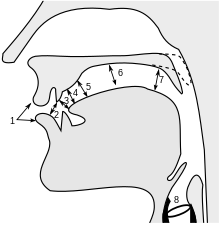Hard and soft G in Dutch
Hard and soft G in Dutch (Dutch: harde en zachte G) refers to a phonological phenomenon of the pronunciation of the letters ⟨g⟩ and ⟨ch⟩ and also a major isogloss within that language.
In northern dialects of Dutch, the letters represent velar ([ɣ] and [x], respectively) or uvular fricatives [χ], the so-called hard G.
However, in most northern dialects, the distinction is no longer made, with both sounds pronounced as [x] or [χ]. In those dialects that merge ⟨g⟩ and ⟨ch⟩, it is still possible for some speakers to pronounce ⟨g⟩ as [ɣ] intervocallically.
In many southern dialects of Dutch, ⟨g⟩ and ⟨ch⟩ represent front-velar fricatives ([ɣ̟] and [x̟]), the so-called soft G.
Pronunciation

Overview
- Hard ⟨g⟩ pronunciation:
- ⟨g⟩ represents [ɣ], [x] or [χ], a voiced velar, a voiceless velar or a voiceless uvular fricative, depending on the dialect.
- ⟨ch⟩ represents [x] or [χ], a voiceless velar or a voiceless uvular fricative, depending on the dialect.
- Soft ⟨g⟩ pronunciation:
- ⟨g⟩ represents [ɣ̟], a voiced front-velar fricative.
- ⟨ch⟩ represents [x̟], voiceless front-velar fricative.
Examples
| Symbol | Example | |||
|---|---|---|---|---|
| IPA | orthography | Gloss | ||
| [x] / [χ] (Hard G) | [ɑxt] / [ɑχt] | acht | 'eight' | |
| [x̟] (Soft G) | [ɑx̟t] | |||
| [ɣ] / [x] / [χ] (Hard G) | [ɣaːn] / [xaːn] / [χaːn] | gaan | 'to go' | |
| [ɣ̟] (Soft G) | [ɣ̟aːn] | |||
Geographical distribution
The hard ⟨g⟩ is used primarily in the northern part of the Dutch language area in Europe:
- All of the Netherlands, except the provinces of Limburg and most parts of North Brabant, and some dialects of Gelderland and Utrecht
- Most dialects of West Flanders and East Flanders. Those dialects, both in Belgium, as well as the ones of Zeeland, realise ⟨g⟩ as [ɣ ~ ɦ], and ⟨ch⟩ as [x ~ h]. Since those dialects usually feature H-dropping as well, ⟨g⟩ does not merge with ⟨h⟩.
The soft ⟨g⟩ is used primarily in the southern part of the Dutch language area in Europe:
- The Netherlands
- The provinces of Limburg and North Brabant, except for the western part of North Brabant.
- Parts of the province of Gelderland namely the Bommelerwaard, Betuwe, the region surrounding and including Nijmegen, Land van Maas en Waal, the southern part of the Veluwe and the Achterhoek.
- The southeastern part of the province of Utrecht.
- Dutch-speaking Belgium except for most of West Flanders and East Flanders.
See also
